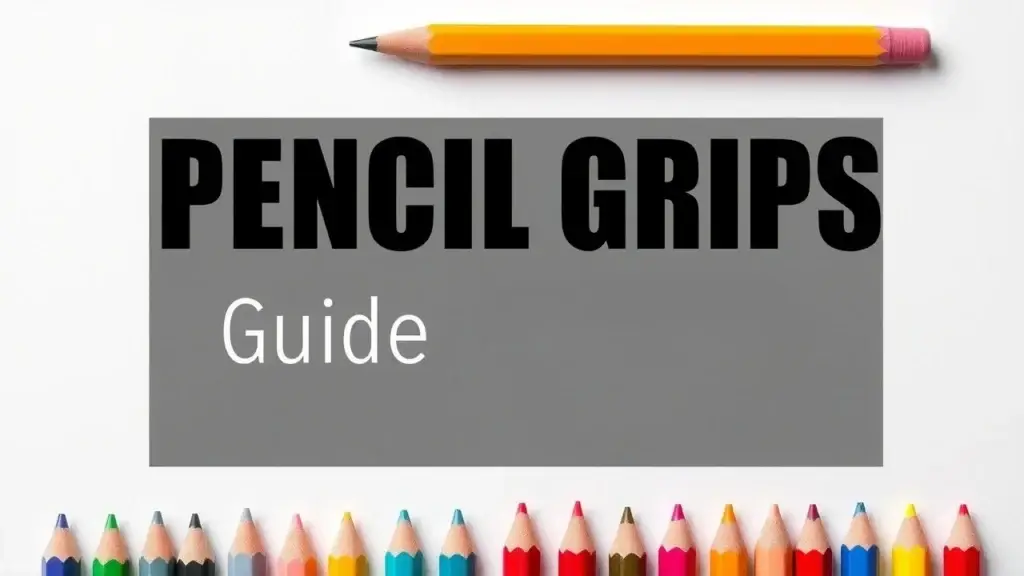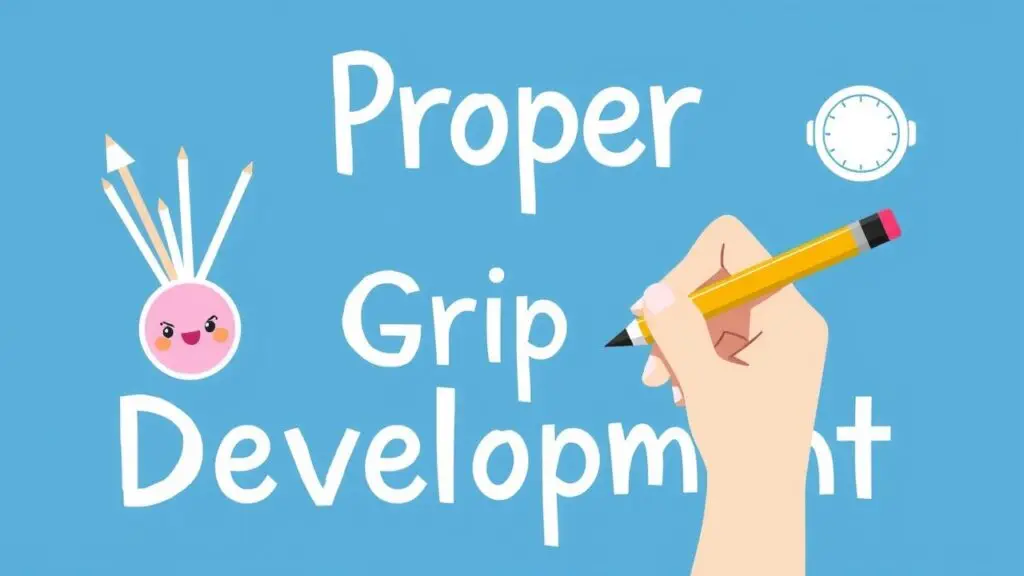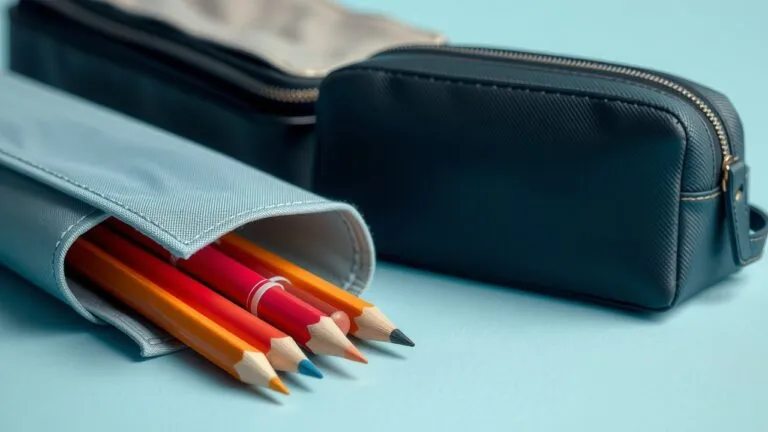Learn about different types of pencil grips for improved handwriting and fine motor skills. This guide helps kids, adults, and therapists understand and address common grip problems.
What Is a Pencil Grip?

A pencil grip is a tool that helps people hold pencils and other writing instruments better. It makes writing easier and more comfortable. There are many types of pencil grips available, each one serving different needs. An ergonomic pencil grip is designed to help reduce hand strain, allowing users to write for longer without feeling tired.
Why Do Pencil Grips Matter?
Pencil grips are important because they affect handwriting quality. Using the right grip can improve fine motor skills, which helps in forming letters and making writing neat. If someone uses the wrong grip, it might lead to messy handwriting or discomfort in the hand. For kids, learning the correct grip is not just about good grades; it also boosts their confidence in writing. With the right pencil grips, people can really enhance their handwriting.
Overview of Common Types of Pencil Grips
There are several common types of pencil holds that work for both kids and adults:
- Tripod Grip: This grip uses three fingers—thumb, index finger, and middle finger. It offers good control and stability when writing.
- Dynamic Tripod Grip: Similar to the tripod grip, this one allows more finger movement, which is great for quick and fluid writing styles.
- Quadrupod Grip: This grip uses four fingers to hold the pencil. It’s often found in younger kids who are still developing their grip skills.
- Immature Grasps: These include various non-standard ways of holding a pencil. They can make it hard to control writing movements or shape letters correctly.
Understanding these types of pencil grips helps teachers and parents choose the right options for their children or themselves—whether starting off with good habits early on or finding comfortable solutions for adults who struggle with standard grips.
Understanding Different Types of Pencil Grips
Tripod Grip (Traditional)
The tripod grip is a popular way to hold a pencil. In this grip, the thumb and index finger pinch the pencil while it rests on the middle finger. This setup gives good control and stability for writing.
Using the tripod grip has many benefits. It’s recognized by teachers and therapists as an effective method for proper handwriting. Kids find it easy to learn, making it one of the best grips for beginners. This grip allows users to write clearly with less effort.
Dynamic Tripod Grip
The dynamic tripod grip improves upon the traditional version. Here, fingers relax a bit more, which helps with precision while reducing hand strain. Instead of holding tightly, fingers can move freely while still keeping control over each stroke.
This ergonomic design is great for longer tasks, like taking tests or working on detailed drawings. It helps prevent tiredness in hand muscles, so people can write comfortably and accurately without slowing down.
Quadrupod Grip
The quadrupod grip adds another finger—usually the ring or pinky—making four points of contact with the pencil. This grip offers extra stability, making it suitable for both adults and children who are learning to write.
However, there are some downsides. Users might write more slowly because more fingers are involved in gripping the pencil compared to other grips like the tripod grip. When choosing a pencil hold, it’s good to think about your needs based on age and skills.
Lateral/Side Grip
In the lateral or side grip, fingers rest along one side of the pencil while the thumb applies pressure from the opposite side. This method provides stability against sideways movements when writing.
This grip is particularly useful for people with certain hand issues, as it reduces strain during use. While it can help lessen discomfort during long writing sessions, it may result in less precise handwriting since fewer fingers are actively forming letters compared to traditional grips.
Comparison of Pencil Grips
Understanding the different types of pencil grips can help improve handwriting for both kids and adults. Each grip type has its own advantages and may work better for different people based on their needs.
| Type | Finger Position | Thumb Placement | Best For | Advantages | Disadvantages |
|---|---|---|---|---|---|
| Traditional Tripod | Three fingers | Opposes index finger | Beginners | Commonly used | Can cause strain during long use |
| Dynamic Tripod | Relaxed three fingers | Balanced thumb | Longer tasks | Better control | Takes practice |
| Quadrupod | Four fingers | Supports middle finger | Kids & adults | Stable grip | Might slow writing down |
| Lateral/Side | Side resting position | Opposes side pressure | Hand conditions | Reduces strain | Less precise |
Types of Pencil Grips Explained
Traditional Tripod Grip: This is a very common grip. It uses three fingers to hold the pencil. The thumb is opposite the index finger, giving it a strong base. It’s good for beginners but can tire out your hand if you write too long.
Dynamic Tripod Grip: Here, you keep a loose hold with three fingers while the thumb rests on top. This grip helps with control and movement, making it better for longer writing sessions.
Quadrupod Grip: This grip uses four fingers instead of three. The middle finger supports the pencil along with the other fingers. This grip is great for kids learning to write and adults who need extra stability.
Lateral/Side Grip: In this style, you hold the pencil against the side of your hand rather than using your fingertips. This method is helpful for people with certain hand conditions because it reduces strain, but it might not be as precise.
Choosing a suitable grip depends on what feels comfortable and what you need for writing. Testing out different grips can help you find one that works best for you!
How Do Different Pencil Grips Affect Handwriting?
The way you hold your pencil matters a lot. Different pencil grips can change how clear and fast your handwriting is. This happens because each grip affects finger placement and how much pressure you use while writing.
Effects on Legibility
Some grip types, like the tripod grip, help you control the pencil better. This means you can form letters more clearly, making your writing neat and easy to read. Good grips make it easier to write consistent letters. On the flip side, using the wrong grip can lead to messy handwriting that’s hard for others to read.
Influence on Speed
The way you hold your pencil also impacts how quickly you write. A relaxed grip helps your hand move smoothly across the page, allowing you to write faster without losing quality. If your grip is too tight or uncomfortable, it can slow you down because your hand gets tired easily.
Ergonomic Designs and Writing Posture
Using ergonomic pencil grips can help with wrist position and reduce strain when writing for a long time. These grips support good writing posture, letting fingers rest comfortably while still having control over the pencil. Keeping a proper posture not only makes writing more comfortable but also helps prevent injuries from doing the same motion too much.
Connection Between Muscle Development and Handwriting Techniques
Different ways of holding a pencil work different muscles in your hand and fingers. By practicing with proper grips, you strengthen those muscles. Over time, this helps improve fine motor skills and coordination, making it easier to write well. Kids who learn effective gripping methods often see their handwriting improve as they build dexterity.
Understanding how various types of pencil grips influence legibility, speed, and ergonomics is essential. Making informed choices about grip can enhance your writing experience greatly.
Choosing the Right Pencil Grip Based on Needs
Choosing the right pencil grip can make writing easier and more comfortable for everyone, especially children and adults with special needs. Several factors affect this choice, such as age group, writing style, physical requirements, and the materials used.
Age Group (Toddlers vs Preschoolers vs Elementary Students)
When picking a pencil grip for different age groups, think about their growth stages. For toddlers, thicker grips are great because they help develop fine motor skills. The best pencil grip for preschool kids often has fun colors or designs to keep them interested while helping them hold the pencil correctly. As kids reach elementary school, they may prefer more structured grips like ergonomic ones that make long writing sessions less tiring.
- Toddlers: Thicker grips; easy-to-hold designs.
- Preschool: Colorful grips; beginner-friendly shapes.
- Elementary School: Ergonomic grips; dynamic tripod styles.
Writing Style Preferences
People have different ways of writing. Some like a relaxed grip that lets their hand move freely across the page. Others need a tighter hold for better control and neatness. Knowing your personal preferences can help you find the right writing grip that feels good while you write.
Physical Needs Such as Arthritis or Dysgraphia Support Tools
If someone has arthritis or dysgraphia, finding ergonomic writing tools is really important. These tools help reduce strain on fingers and hands while giving better control over how you write. A good pencil grip for arthritis should be soft and designed to lessen pressure points. Tools for dysgraphia focus on making handwriting clearer by offering support during writing.
Comfort Level with Various Materials (Rubber/Silicone/Plastic)
The material of a pencil grip can change how it feels to use. Silicone grips offer good traction but can feel sticky when it’s hot outside. Rubber grips are soft but might wear out quicker. Plastic grips last longer but can feel hard against your fingers. Considering what material feels best will lead to a better experience when using different types of pencil grips.
Best Pencil Grips for Children Developing Fine Motor Skills
Kids who are working on their fine motor skills need supportive aids that encourage the right technique without making them frustrated. Triangular-shaped pencils are great because they help with finger placement while being fun enough to keep young learners interested in practicing their handwriting.
Adaptive Options Like Foam or Triangle-Shaped Aids Designed Specifically for Therapeutic Purposes
Adaptive tools are key in helping those who struggle with writing due to physical challenges or learning difficulties. Foam triangle-shaped aids give both structure and comfort—these are perfect when trying to improve dexterity in kids learning to write or adults dealing with discomfort from long periods of writing.
Tools & Techniques to Improve Your Pencil Grip

What are pencil grip aids?
Pencil grip aids are special tools that help people hold writing instruments better. These adaptive writing tools can make writing easier and more comfortable, especially for those who find regular grips hard to manage. Ergonomic writing tools aim to lessen strain on the fingers and hands, allowing users to write neatly without pain. Therapeutic interventions often use these aids in settings like occupational therapy to boost fine motor skills.
Top-rated ergonomic products available online/offline
When looking for the best pencil grips, you’ll find many options suited for various needs:
- Silicone Sleeves
Silicone sleeves give a soft, non-slip surface that helps control your writing. They’re great for folks who get tired easily when they write for long periods. - Rubber Holders
Rubber holders add a comfy cushion, making it easier to hold onto your pencil without squeezing too hard. This makes them perfect for kids just learning or adults wanting more comfort. - Foam-based Supports
Foam grips mold well to different finger sizes because they’re soft. They improve comfort during long writing sessions by spreading out pressure across fingers. - Weighted Pencils
Weighted pencils help those with fine motor skill challenges by providing extra stability when holding a pen or pencil. The added weight can make it easier to control your writing.
Exercises to strengthen grasp patterns
To really boost your grasp patterns, try these fun activities that help with hand skills:
- Join in on fine motor activities like threading beads or stacking small blocks.
- Play “Treasure hiding” games that encourage pinch strength through fun exploration.
- Squeeze stress balls or putty regularly; this helps build hand muscles over time.
- Cut shapes with scissors; this activity improves finger coordination and strength.
By practicing these exercises often, you’ll likely see improvements in both your handwriting skills and comfort using various pencil grips.
Addressing Common Concerns About Improper Grasp Patterns
Understanding improper grasp patterns is important for parents and teachers. These patterns can lead to handwriting difficulties and affect a child’s writing readiness.
Signs Your Child Might Need Intervention from an Occupational Therapist
Look out for signs that may mean your child needs help with their pencil grip. Key signs include:
- Difficulty holding a pen correctly: If your child struggles to control their pen while writing, it could be a problem.
- Frequent hand cramps: This may happen during tasks that require writing.
- Avoidance of writing activities: If your child tends to shy away from writing or looks frustrated when asked to write, this is worth noting.
If you see these signs, it might be time to talk with an occupational therapist who specializes in handwriting therapy. They can provide support and offer adaptive writing tools that can make writing easier.
Developmental Milestones Related to Mature Grasp Formation at Different Ages
Children develop mature grasp patterns at different ages. Here’s a quick look at the typical milestones:
- Age 3: Many kids start using a basic grip.
- Ages 4-5: More refined grips usually begin to form as fine motor skills improve.
- Ages 6-7: By this age, most children have developed the tripod grip, which is common among good writers.
Recognizing these milestones helps parents see if their child’s grasp pattern fits with normal development. If not, it might be time for further evaluation.
Impact of Sensory Processing Issues or Coordination Disorders on Handwriting Ability
Sensory processing disorder (SPD) can greatly affect how children hold pencils and control their movements. Kids with proprioception issues may find it hard to be aware of where their body is in space. This can lead to problems like poor handwriting because they don’t have enough grip strength or control.
Therapeutic interventions that focus on sensory integration can help improve fine motor skills and comfort during writing tasks. Knowing how these issues impact handwriting ability lets parents and teachers better support affected children.
How Adaptive Tools Can Help Mitigate These Effects?
Adaptive tools play a key role in helping kids with improper grips. Ergonomic pencil grips are designed to fit comfortably in small hands and help promote correct finger placement during writing tasks.
Some adaptive tools you might consider include:
- Specialized ergonomic grips: These are made for kids who need extra support.
- Larger models for adults: Good for those needing support due to conditions like arthritis or dysgraphia.
Using these tools can make writing more comfortable and boost a child’s confidence. Making writing less intimidating helps young writers feel better about themselves.
Frequently Asked Questions About Pencil Grips
What are the benefits of using different pencil grips?
Different pencil grips can improve handwriting and reduce discomfort. They help develop fine motor skills, support proper finger placement, and make writing more enjoyable.
How do I choose a pencil grip?
Choose a pencil grip based on age, writing style, and any physical needs. Look for grips that feel comfortable and promote good writing posture. Consider adaptive options if needed.
What types of pencil grips work best for kids with special needs?
Adaptive pencil grips, like foam or larger ergonomic grips, support kids with special needs. These grips can help children with conditions like dysgraphia or sensory processing disorder.
Are there specific grips for left-handed writers?
Yes, left-handed writers benefit from specially designed grips that accommodate their unique holding position. These grips enhance comfort and control during writing.
Can using an ergonomic pencil grip reduce hand fatigue?
Yes, ergonomic grips are designed to lessen strain on the hand. They promote a relaxed writing posture, making it easier to write for extended periods without discomfort.
What is the best pencil grip for improving handwriting speed?
The dynamic tripod grip is often the best choice for speed. It allows fluid movement while maintaining control, helping writers move quickly across the page.
Where can I find affordable adaptive writing tools?
You can find budget-friendly adaptive writing tools at educational supply stores and online platforms like Amazon or Walmart.
Additional Insights on Pencil Grip Varieties
- Pencil Grip Sizes: Pencil grips come in various sizes to fit different hands.
- Materials: Common materials include rubber, silicone, and plastic for comfort.
- Reviews: Check user reviews to find effective pencil grip solutions.
- Therapeutic Uses: Occupational therapy often uses specific grips for improved fine motor skills.
- Grip Strengtheners: Exercises can help build grip strength and improve overall control.
- Writing Tools: Explore ergonomic designs that enhance comfort during long writing tasks.
- Support for Disabilities: Specialized grips assist adults with disabilities in achieving better handwriting outcomes.
- Pre-Writing Tools: Grips designed for preschoolers help lay the foundation for strong writing skills.
- Correcting Grasp Patterns: Identifying improper grasp patterns early aids in correcting them efficiently.
- Adaptive Equipment: These tools are crucial in facilitating handwriting development in children with learning disabilities.
This content highlights key aspects of choosing and using different types of pencil grips effectively.
Related Topics
- Types of Pencil Holds
- Types of Ergonomic Pencil Grips
- Types of Adaptive Pencil Grips
- Types of Pencil Grip Aids
- Types of Grasps (Handwriting)
- Types of Handwriting Grips for Kids
- Types of Handwriting Grips for Adults
- Types of Pencil Grip Materials
- Types of Handwriting Therapy Tools



Types of Pencil Grips: A Guide for Kids, Adults & Therapists